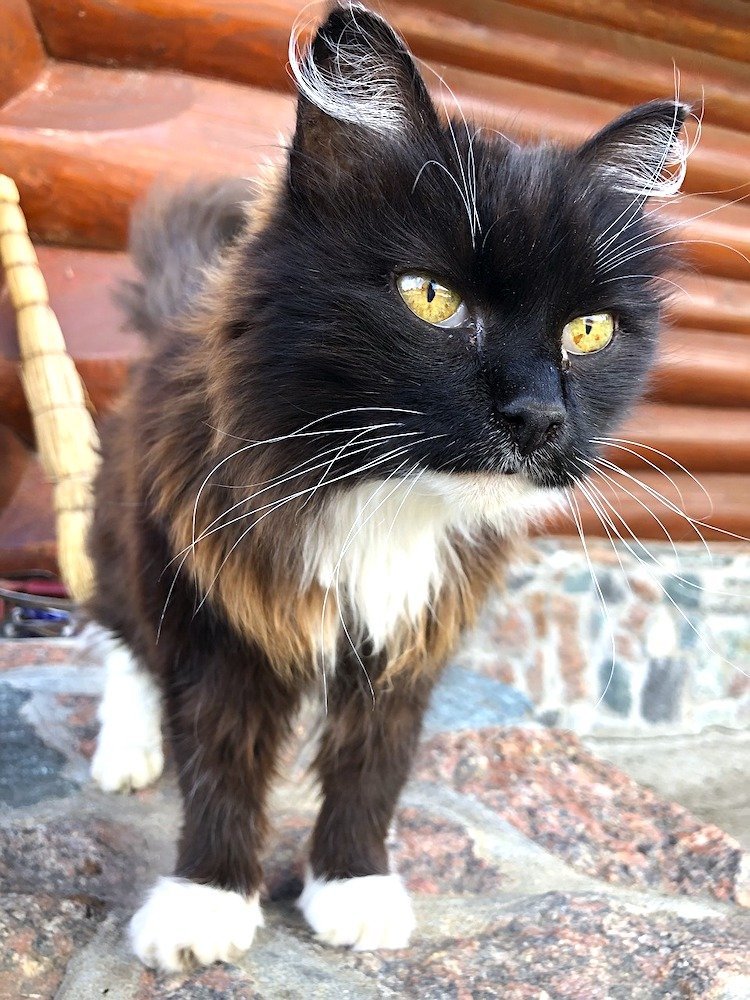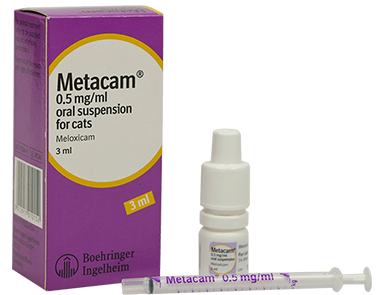
This expert guide to treating cat arthritis was written by a team of veterinarians., Dr. Pippa Elliott, BVMS, MRCVS, and Dr. Debora Lichtenberg, VMD. It was reviewed for accuracy by Dr. Elliott and was last updated on July 16, 2024
If you have questions or concerns, call your vet, who is best equipped to ensure the health and well-being of your pet. This article is for informational purposes only and is not a substitute for professional medical advice, diagnosis, or treatment. See additional information.

Could Your Cat Have Arthritis and Be Suffering From Cat Arthritis in Silence?
George may still be curious, but if his aging joints are keeping him from poking around the house, he may be suffering from arthritis. While an older dog might show obvious signs of arthritis, your cat may be in the same amount of discomfort — but because cats are cats, they may be in pain under your radar.
Signs of Cat Arthritis
- If Curious G isn’t getting on the bed as much or isn’t jumping up to drink from the sink anymore, this could be significant.
- Maybe he looks at the windowsill and acts as if he’d just rather sleep on the floor.
- Cats prefer perches and higher ground. If your cat is hesitating to jump or is looking at his favorite chair and then just walking away, maybe old George is in considerable arthritic pain.
Factors Contributing to Feline Arthritis
- Age: Most cats don’t develop obvious signs of arthritis until they are at least 10 years old.
- Weight: An obese cat has a much harder time dealing with aging joints.
- Health Status: Overall health can impact joint health.
- Previous Injuries: Injuries sustained earlier in life can lead to arthritis as the cat ages.

Arthritis in Cats: 8 Questions to Ask Yourself
Because you live with your cat, it’s often hard to spot those telltale changes that indicate sore joints. Most cases of arthritis in cats are picked up by the veterinarian during vaccine checks.
Sit down and think about these questions:
- Is your aging cat less active lately?
- Do they have difficulty jumping up onto a favorite perch or window ledge?
- Are they grumpier than they used to be?
- Is your cat having regular accidents outside the litter box?
- Has their coat care gone downhill — is the coat dull or matted?
- Do they look stiff and sore when they wake?
- Is the cat a Maine Coon or Burmese? (These two breeds are prone to arthritis.)
- Does the cat crouch awkwardly, as if their joints are stiff?
If you answered “yes” to any of these 8 questions, then arthritis is a possibility. Please discuss this with your vet.
Other Conditions That Can Worsen Arthritis
Keep in mind that other conditions that can decrease your cat’s energy or affect their hydration status can certainly make arthritis worse, such as:
If your cat had a broken bone or a dislocated hip earlier in life, that joint has a higher risk of becoming arthritic as the cat ages.
Diagnosing Arthritis in Cats
Diagnosis of arthritis in cats is relatively straightforward. You usually notice stiffness, a limp, slowness, or an inability to jump.
Recommended Diagnostic Steps
- Geriatric Workup: Since this is generally a geriatric problem in cats, a geriatric workup including blood work is usually recommended to make sure the cat does not have some underlying metabolic disease causing slowness or a change in gait.
- X-Rays: X-rays are also beneficial to confirm the diagnosis and rule out other problems that cause stiffness, pain, or lameness.

Treatment of Arthritis in Cats
Treating cat arthritis can be more challenging than treating dog arthritis for a couple of reasons:
- Medication Challenges: If medication is needed for cat arthritis, we all know how difficult daily dosing of meds can be in a cat.
- Anti-Inflammatory Issues: Cats have peculiar problems when it comes to using anti-inflammatories, the mainstay of treating arthritis. Many drugs are just not safe for use in cats.
Pain Relief for Cats with Arthritis
As many pet owners know, Tylenol (acetaminophen) can kill a cat and is dangerous for dogs too.
NSAIDs and Cats
- Watchlist Drugs: Drugs called NSAIDs (non-steroidal anti-inflammatories) should also be on your watchlist. Cats break down NSAIDs very differently from humans or dogs. This is why aspirin should never be given to cats without supervision.
Meloxicam (Metacam) for Pain Relief
- Licensed Pain Relief: However, an NSAID called Meloxicam (Metacam) is now well-established as licensed pain relief for cat arthritis. Because it’s a liquid that you place on food, it’s easy to give. (Cats seem to love it, although to me it smells like a ferret coated in honey.)
- Benefits vs. Risks: Of course, there are some risks attached, which we’ll look at shortly. But for those uneasy about giving cats medication, weigh the benefits of reducing pain and improving quality of life against a small risk when used correctly.

Meloxicam Dosage and Side Effects for Cats
Proper Dosage
Feline Metacam (0.5 mg/ml) is not as strong as canine Metacam (1.5 mg/ml). If you have dog Metacam at home, do not give it to the cat. Use only the specially formulated feline version or you risk overdose.
- Dosage Calculation: The dose of cat Metacam for cat arthritis works out at 0.1 ml/kg body weight. So our furry 5 kg friend takes 0.5 ml of cat meloxicam (0.5 mg/ml oral suspension).
Potential Side Effects
Side effects may include:
- Sickness
- Diarrhea
- Kidney damage
These can be minimized by giving with food, having regular kidney checks, and stopping the medication if the cat has an upset stomach.
Nutraceuticals for Arthritic Cats
Think of a nutraceutical as a food supplement with health benefits for cat arthritis. Indeed, the best nutraceuticals can have a drug-like effect, but without the drawbacks of medicine.
They are often slow-acting, and when given in the long term, may help aging joints to feel better or lessen future deterioration. Joint nutraceuticals in particular are said to give the joints the building blocks for repair and increase the slipperiness of joint fluid, both of which help mobility.
Pros and Cons of Nutraceuticals for Arthritic Cats
- Pro: They are usually harm-free.
- Con: There are lots of products out there with false claims on the label.
A drawback of nutraceuticals is they aren’t regulated as tightly as drugs. Whereas a drug goes through rigorous (and costly) trials before any claims can be put on the label, this is not the case for nutraceuticals. Thus, Manufacturer A could claim your cat will grow wings when given this product, and there’s nothing to stop them.
Was YOUR Pet Food Recalled?
Check Now: Blue Buffalo • Science Diet • Purina • Wellness • 4health • Canine Carry Outs • Friskies • Taste of the Wild • See 200+ more brands…

Even more worryingly, there’s no legal requirement to prove the pack contains the strength printed on the label. From a discount store, you may bag a bargain of “gazillion mg evening primrose oil capsules” for your cat, but there’s no guarantee the package will actually contain this.
Nutraceutical Need-to-Know Points
- Nutraceuticals do not provide any pain relief.
- They are a long-term investment rather than a quick fix for your pet’s joint health.
- You get what you pay for. Yes, nutraceuticals from your vet are more expensive, but they’re more likely to be brands that abide by a voluntary code that guarantees strength and efficacy.
Nutraceutical Dosage and Side Effects
First, nutraceuticals are safe, with diarrhea being the most likely symptom of overdose. If this happens, simply stop, wait 1–2 days, then restart on a half dose.
Also, vets recommend giving a loading dose for 1 month, which is twice the maintenance dose. This helps flood the joints with all those lovely soothing molecules to get things off to a swinging start.
- Glucosamine: Around 22 mg/kg per day. A 5 kg cat needs around 110 mg daily.
- Chondroitin: 15–20 mg/kg each day. So a 5 kg cat should take around 100 mg daily.
- Glucosamine and Chondroitin: Each of these helps the other work better, which is why you so often see them used in combination. Choose a combined product for maximum effectiveness.
- Vitamin E: 200–600 IU twice a day.
- Omega-3 Fatty Acids: Best given with food for maximum action. A recommended dose is 75 mg/kg per day. Our 5 kg cat, therefore, needs around 375 mg daily. (For more, see our related article, “The Skinny on Fatty Acid Supplements for Pets.”)
If your cat is impossible to pill, look out for one of the joint-friendly foods. Some of these “prescription pet foods” have impressive data behind them, where cats’ mobility and pain were measured before and after feeding, and those fed the diet showed noticeable improvements.
Joint Nutraceuticals
For further information on joint nutraceuticals, check out this article on joint supplements and their benefits for arthritic cats.
Other Options for Relieving Arthritis in Cats
Arthritis is a condition where lots of small things can add up to a big improvement. So don’t feel helpless, because making minor adjustments can help.
For example, my favorite tips are:
- Heat Therapy: Get your cat a heat pad, or better still a heated cat bed. They’ll love you fur-ever as they snuggle up in that lovely warmth that penetrates their joints to ease those aches.
- Warm Bags: Invest in some microwaveable wheat/corn bags. Then place the warm bag over the sore joint for extra relief.
- Jumping Assistance: Provide a stool or chair as a staging post to help your cat jump up to a favorite spot.
- Massage: When done correctly, massage helps remove inflammatory toxins away from inflamed joints and increases the supply of healing oxygen. However, do massage wrong and you can do harm. Therefore, find a veterinary physiotherapist and have them teach you what to do.
- Nail Trim: Watch out for overgrown nails that can dig into the pad. When an arthritic cat is less active, those nails can grow surprisingly fast.
Therapies, New and Old
As vets take a more holistic approach to managing arthritis in cats, here are some options to consider:
- Acupuncture: Scientific studies in people indicate acupuncture does produce positive results. Anecdotally, people report how their cats purr their way through acupuncture sessions and seem improved afterward.
- Laser Therapy: Again, the application of targeted laser therapy seems to greatly improve the mobility of some cats … and they seem to love the sessions.
- Hydrotherapy: Yes, you can train a cat to walk on a water treadmill. This builds muscular strength, which in turn supports those sore joints.
- Stem Cell Therapy: This is a hyper-modern approach that appears to be of benefit for dogs with arthritis. For many the jury is still out, and it can be frustrating to find a clinic that offers this treatment. For those wishing to pursue every option, this is one to research.
And now, here’s a fun video of a cat getting the best massage of his life:
Final Thoughts on Treating Cat Arthritis
If your aging cat is starting to show changes in mobility, have a conversation with your veterinarian. I think arthritis in cats is under-diagnosed. We need to be more aware of our cats’ subtle movement changes, diagnose their pain and help them.
There are lots of options to ease their discomfort, so don’t duck away but face things head on.
Frequently Asked Questions (FAQ)
How to carry a cat with arthritis?
To carry a cat with arthritis, support its body fully by placing one hand under its chest and the other under its hindquarters.
How long can a cat live with arthritis?
A cat can live a long, comfortable life with arthritis if managed properly with veterinary care, appropriate medications, and lifestyle adjustments.
What can I give my cat for arthritis pain?
For arthritis pain in cats, you can give vet-prescribed medications like meloxicam and supplements like glucosamine and chondroitin.
References
- Downing, Robin, DVM, DAAPM, DACVSMR, CVPP, CRPP. “Arthritis in Cats.” VCA Hospitals. 2017. https://vcahospitals.com/know-your-pet/arthritis-in-cats.
- Harari, Joseph, DVM, DACVS. “Joint Disorders in Cats.” Merck Veterinary Manual. https://www.msdvetmanual.com/cat-owners/bone,-joint,-and-muscle-disorders-of-cats/joint-disorders-in-cats.
- “Metacam 0.5 mg/ml Oral Suspension for Cats and Guinea Pigs.” National Office of Animal Health. https://www.noahcompendium.co.uk/?id=-447596.



